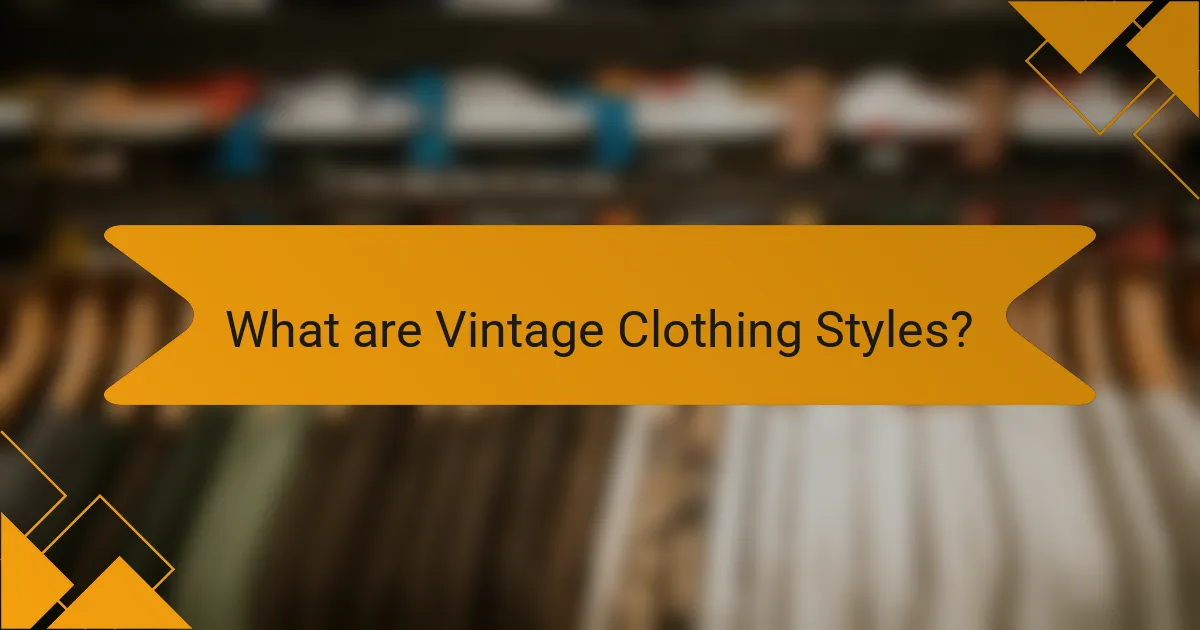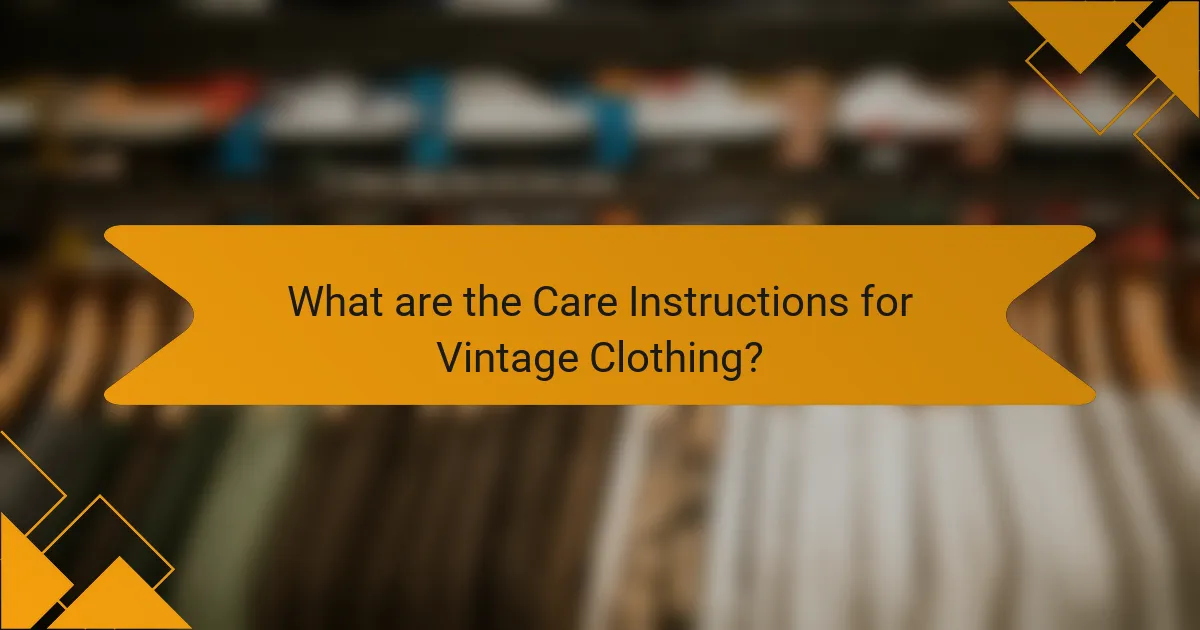Vintage clothing styles encompass fashion items that are at least 20 years old, showcasing trends and cultural influences from various past decades. This article examines the distinctive characteristics of popular vintage styles, such as 1920s flapper dresses, 1950s rockabilly outfits, and 1970s bohemian attire, highlighting their unique designs and materials. Additionally, it provides essential care instructions for preserving vintage garments, including washing techniques and storage recommendations. The article also offers practical sourcing tips for finding vintage clothing through thrift stores, estate sales, and online marketplaces, emphasizing the importance of quality and authenticity in the selection process.

What are Vintage Clothing Styles?
Vintage clothing styles refer to fashion items that are at least 20 years old. These styles often reflect the trends and cultural influences of their respective eras. Common vintage styles include 1920s flapper dresses, 1950s rockabilly outfits, and 1970s bohemian attire. Each vintage style has unique characteristics that distinguish it from contemporary fashion. For example, 1920s styles often feature dropped waistlines and intricate beadwork. The 1950s introduced full skirts and tailored silhouettes. Vintage clothing is often sought after for its quality and craftsmanship. Many vintage pieces are made from durable materials that are no longer commonly used. Collectors appreciate the historical significance and nostalgia associated with these styles.
How do Vintage Clothing Styles differ from modern fashion?
Vintage clothing styles differ from modern fashion primarily in their design aesthetics and cultural influences. Vintage styles often feature unique patterns, textures, and silhouettes that reflect the trends of specific historical periods. For example, the 1920s flapper dresses emphasize a loose fit and intricate beadwork. In contrast, modern fashion tends to prioritize minimalism and functionality, often utilizing synthetic materials.
Additionally, vintage clothing is typically characterized by its craftsmanship and attention to detail, with many pieces handcrafted. Modern fashion, however, frequently relies on mass production techniques, which can compromise quality. Vintage items also carry a sense of nostalgia and individuality, as they are often one-of-a-kind finds.
Furthermore, the sustainability aspect of vintage clothing appeals to consumers looking for eco-friendly alternatives. In contrast, modern fashion often faces criticism for fast fashion practices that contribute to environmental waste. Overall, the differences between vintage clothing styles and modern fashion lie in their design, production methods, and cultural significance.
What historical periods influence Vintage Clothing Styles?
Vintage clothing styles are influenced by several historical periods. Key influences include the Victorian era, which introduced elaborate designs and fabrics. The Roaring Twenties brought flapper dresses and shorter hemlines. The 1950s emphasized tailored silhouettes and rockabilly aesthetics. The 1970s introduced bohemian styles with vibrant colors and patterns. Each of these periods left a distinct mark on vintage fashion. For example, clothing from the 1960s featured bold prints and mod styles. The 1980s contributed oversized silhouettes and neon colors. Collectively, these eras shape what is recognized as vintage today.
What are the key characteristics of popular Vintage Clothing Styles?
Popular vintage clothing styles are characterized by distinct aesthetics, materials, and historical influences. These styles often reflect the fashion trends of specific decades, such as the 1920s flapper dresses or the 1970s bohemian looks. Key characteristics include unique patterns, bold colors, and tailored fits that differ from contemporary fashion. Fabrics like cotton, silk, and wool are commonly used, often featuring intricate detailing. Many vintage pieces showcase craftsmanship that is less common in modern clothing. Additionally, vintage styles may incorporate nostalgic elements, evoking a sense of history and individuality. Popularity is often linked to cultural movements and iconic figures from the past, making these styles timeless in appeal.
Why is Vintage Clothing popular today?
Vintage clothing is popular today due to a growing interest in sustainability and individuality. Consumers increasingly seek unique items that stand out from mass-produced fashion. Vintage clothing offers historical significance and a sense of nostalgia. The rise of social media has amplified trends, showcasing vintage styles to a wider audience. According to a 2021 ThredUp report, the secondhand market is projected to reach $64 billion by 2024. This growth reflects a shift in consumer behavior towards eco-friendly choices. Additionally, vintage clothing often features high-quality materials and craftsmanship. These attributes appeal to those who value durability and timeless style.
What cultural movements have contributed to the resurgence of Vintage Clothing?
The resurgence of vintage clothing has been significantly influenced by several cultural movements. The environmental sustainability movement encourages consumers to choose second-hand clothing to reduce waste. The retro revival trend celebrates past fashion eras, making vintage styles desirable. The rise of social media platforms allows influencers to showcase vintage outfits, increasing their popularity. Additionally, the DIY culture promotes personal expression through unique vintage finds. The nostalgia for past decades, particularly the 1960s to 1990s, has led to a renewed interest in vintage aesthetics. These movements collectively contribute to the growing appreciation and demand for vintage clothing.
How does Vintage Clothing promote sustainability in fashion?
Vintage clothing promotes sustainability in fashion by reducing waste and extending the lifecycle of garments. By choosing vintage, consumers opt for pre-owned items, which minimizes the demand for new production. This practice helps decrease the environmental impact associated with manufacturing, such as water usage and carbon emissions. Additionally, vintage clothing encourages a circular economy by allowing garments to be reused and repurposed. Studies show that extending the life of clothing by just nine months can reduce carbon, water, and waste footprints by 20-30%. Thus, vintage clothing plays a crucial role in promoting sustainable fashion practices.

What are the Unique Characteristics of Vintage Clothing Styles?
Vintage clothing styles are characterized by their distinct designs, materials, and historical significance. These garments often reflect specific fashion trends from past decades. Common periods include the 1920s flapper dresses and the 1970s bohemian styles.
Unique attributes include the use of high-quality fabrics like silk and wool, which were more prevalent in earlier eras. Additionally, vintage clothing often features intricate details such as hand-sewn embellishments and unique prints.
The rarity of certain pieces adds to their appeal, as many items are no longer in production. Vintage clothing also carries a sense of nostalgia, connecting wearers to cultural history. Collectors value items based on provenance, making some pieces highly sought after.
Overall, vintage clothing styles offer a unique blend of aesthetics, craftsmanship, and historical context.
What materials are commonly used in Vintage Clothing?
Common materials used in vintage clothing include cotton, wool, silk, and polyester. Cotton is favored for its breathability and comfort. Wool provides warmth and durability, making it ideal for outerwear. Silk is prized for its luxurious feel and sheen. Polyester, introduced in the mid-20th century, offers wrinkle resistance and easy care. Linen is also popular for its lightweight and breathable qualities, especially in summer garments. Each material contributes to the unique appeal of vintage clothing, reflecting different fashion eras and styles.
How do fabric choices impact the quality of Vintage Clothing?
Fabric choices significantly impact the quality of vintage clothing. Different fabrics determine the durability, comfort, and overall appearance of the garments. Natural fibers like cotton, silk, and wool tend to offer better breathability and longevity compared to synthetic materials. For instance, silk garments can retain their shape and luster over decades if properly cared for.
In contrast, synthetic fabrics may degrade faster, affecting the garment’s quality. Additionally, the weight and weave of the fabric influence how well a piece drapes and fits. Heavier fabrics often provide structure, while lighter materials can enhance flow and movement. Historical context shows that vintage clothing made from high-quality materials often commands higher prices in the market. Thus, fabric choices are crucial in determining the overall quality and desirability of vintage clothing.
What are the common patterns and prints found in Vintage Clothing?
Common patterns and prints in vintage clothing include floral, paisley, polka dots, and stripes. Floral prints were especially popular in the 1960s and 1970s. Paisley patterns often reflect the bohemian styles of the 1970s. Polka dots convey a playful aesthetic, commonly seen in 1950s fashion. Stripes can vary in width and color, showcasing styles from various decades. These patterns often embody the cultural and social trends of their time, making them significant in vintage fashion.
How do fit and silhouette vary in Vintage Clothing Styles?
Fit and silhouette in vintage clothing styles differ significantly across eras. Each decade showcases distinct tailoring methods and design philosophies. For example, the 1920s emphasized a loose, straight fit with dropped waistlines. In contrast, the 1950s favored a more structured silhouette, often featuring fitted bodices and flared skirts. The 1970s introduced a relaxed fit with bell-bottoms and maxi dresses, promoting comfort and freedom of movement.
Historical context supports these variations. The post-war era influenced the 1950s’ hourglass figure, reflecting societal ideals of femininity. Meanwhile, the 1960s and 1970s embraced youth culture, leading to more casual and eclectic styles. Understanding these fit and silhouette differences allows for a deeper appreciation of vintage clothing’s evolution and cultural significance.
What are the defining silhouettes of different Vintage eras?
The defining silhouettes of different vintage eras include distinct shapes and styles. The 1920s featured flapper dresses with dropped waists and straight lines. The 1930s introduced more feminine curves with bias-cut dresses that hugged the body. In the 1940s, wartime fashion led to structured silhouettes with shoulder pads and cinched waists. The 1950s celebrated hourglass figures with full skirts and fitted bodices. The 1960s brought a shift to mod styles with A-line dresses and mini lengths. The 1970s embraced bohemian looks with flowing maxi dresses and bell-bottom pants. Each era’s silhouette reflects cultural influences and fashion trends of the time. These characteristics are well-documented in fashion history studies.
How should one choose the right fit when selecting Vintage Clothing?
To choose the right fit when selecting vintage clothing, one should first know their measurements. Accurate measurements include bust, waist, and hip sizes. Vintage sizes often differ from modern sizes, so it’s essential to consult size charts. Trying on the garment is advisable whenever possible. Pay attention to the cut and style of the clothing, as these can affect fit. Fabrics may have less stretch than contemporary materials, impacting comfort. Look for signs of wear that may affect fit, like stretching or shrinking. Research the brand for specific sizing information, as vintage brands can vary widely. Understanding these factors ensures a better fit when selecting vintage clothing.

What are the Care Instructions for Vintage Clothing?
Care instructions for vintage clothing include gentle washing, proper storage, and avoiding harsh chemicals. Hand washing is often recommended to prevent damage. Use cold water and mild detergent for cleaning. Air drying is preferable to machine drying. Store vintage items in a cool, dark place to avoid fading. Use padded hangers for garments to maintain shape. Avoid plastic bags, as they can trap moisture and lead to mildew. Regularly inspect for signs of wear or damage to ensure longevity. These practices help preserve the integrity and appearance of vintage clothing.
How should Vintage Clothing be cleaned and maintained?
Vintage clothing should be cleaned and maintained with care to preserve its quality. Hand washing is often recommended to prevent damage. Use cold water and a gentle detergent suitable for delicate fabrics. Avoid bleach and harsh chemicals that can degrade materials. For stubborn stains, spot cleaning with a mild solution is effective. Air drying is best to prevent shrinkage and fading. Store vintage items in a cool, dry place away from direct sunlight. Use padded hangers for garments and acid-free tissue paper for folded items. Regularly check for pests and signs of deterioration to ensure longevity.
What specific cleaning methods are recommended for delicate fabrics?
Gentle hand washing is the recommended cleaning method for delicate fabrics. This method helps to prevent damage from agitation. Use cold or lukewarm water to avoid shrinking. Mild detergents designed for delicate fabrics should be used. Avoid bleach and harsh chemicals, as they can harm fibers. Rinse thoroughly to remove all detergent residues. Lay the fabric flat to dry, avoiding direct sunlight. If necessary, steam or iron on a low setting to remove wrinkles.
How can one effectively remove stains from Vintage Clothing?
To effectively remove stains from vintage clothing, start by identifying the fabric type. Different fabrics require different cleaning methods. For cotton or linen, a mixture of mild detergent and water can be used. Apply the solution gently to the stained area. For delicate fabrics like silk, use a specialized silk cleaner. Blot the stain instead of rubbing it to avoid damage. Always test a small, inconspicuous area first. For stubborn stains, consider using a stain remover specifically designed for vintage textiles. Rinse thoroughly after treatment to prevent residue. Air dry the garment away from direct sunlight to maintain its color and integrity.
What storage tips are essential for preserving Vintage Clothing?
Store vintage clothing in a cool, dry place to prevent damage. Avoid direct sunlight, which can fade colors and weaken fabrics. Use acid-free tissue paper to stuff garments and maintain their shape. Hang items using padded or wooden hangers to avoid stretching. For delicate pieces, consider folding them in a breathable cotton or linen garment bag. Ensure that the storage area has good ventilation to reduce humidity. Regularly check for pests and signs of mold. These methods help preserve the integrity and appearance of vintage clothing over time.
How should Vintage Clothing be folded or hung for optimal preservation?
Vintage clothing should be hung on padded hangers or folded gently to prevent creasing. Hanging is ideal for garments like dresses and jackets. This method maintains their shape and prevents fabric distortion. Use padded hangers to avoid shoulder bumps. For delicate fabrics, fold items carefully to minimize stress on seams. Store folded clothing in breathable cotton bags. Avoid plastic, as it can trap moisture and lead to mold. Proper storage conditions include a cool, dry place away from direct sunlight. These practices help preserve the fabric and color over time.
What environmental factors should be considered when storing Vintage Clothing?
When storing vintage clothing, consider temperature, humidity, light exposure, and air circulation. Ideal storage temperature is between 60-70°F. High humidity can lead to mold and mildew, so maintain levels below 50%. Exposure to direct sunlight can fade colors and damage fabrics. Use opaque storage containers to block light. Proper air circulation prevents mustiness and protects fibers. Avoid plastic bags, as they can trap moisture. Instead, opt for breathable materials like cotton or acid-free tissue paper. These factors collectively ensure the preservation of vintage clothing.

How can one source Vintage Clothing effectively?
To source vintage clothing effectively, one should explore various avenues such as thrift stores, estate sales, and online marketplaces. Thrift stores often have a rotating selection of vintage items at affordable prices. Estate sales can yield unique finds, especially if the owner had a penchant for vintage fashion. Online marketplaces like Etsy and eBay provide access to a wide range of vintage clothing from different eras. Local flea markets and vintage fairs are also excellent places to discover unique pieces. Networking with vintage clothing enthusiasts can lead to private sales and exclusive finds. Researching specific vintage brands and styles can help identify valuable items. Finally, maintaining a keen eye for quality and authenticity is crucial when sourcing vintage clothing.
What are the best places to find Vintage Clothing?
The best places to find vintage clothing include thrift stores, consignment shops, and online marketplaces. Thrift stores often have a rotating selection of unique items at affordable prices. Consignment shops curate higher-quality vintage pieces, sometimes from well-known brands. Online marketplaces like Etsy and eBay offer a vast range of vintage clothing from various sellers. Estate sales and garage sales can also yield hidden gems. Vintage fairs and flea markets showcase multiple vendors with curated selections. These locations are known for their diverse offerings and can cater to various styles and budgets.
How do thrift stores compare to online marketplaces for sourcing Vintage Clothing?
Thrift stores and online marketplaces both offer unique avenues for sourcing vintage clothing. Thrift stores provide an in-person shopping experience, allowing customers to physically inspect items. This tactile interaction helps assess fabric quality and condition. The inventory at thrift stores often changes frequently, creating a treasure hunt experience.
In contrast, online marketplaces offer a broader selection and convenience. Shoppers can access vintage clothing from multiple sellers worldwide. Online platforms often provide detailed descriptions and photographs, aiding in informed purchasing decisions. However, buyers cannot physically inspect items before purchase.
Statistics show that thrift store prices are generally lower than those on online marketplaces. According to a 2022 survey, thrift store prices average 30-50% less than similar items listed online. This price difference can be significant for budget-conscious shoppers.
Ultimately, the choice between thrift stores and online marketplaces depends on personal preferences for shopping style and budget considerations.
What should one look for when shopping for Vintage Clothing at flea markets?
When shopping for vintage clothing at flea markets, one should look for quality materials and unique designs. Quality fabrics like silk, wool, and cotton indicate durability. Unique designs often reflect the fashion trends of specific decades. Check for brand labels that signify authenticity and value. Inspect the clothing for any signs of wear, such as fraying or stains. Ensure that the item fits well or can be tailored. Researching the era of the clothing can provide context for its style and value. Familiarity with common vintage brands can help identify valuable pieces.
What tips can help ensure a successful Vintage Clothing shopping experience?
Research vintage clothing stores before visiting. Look for shops with positive reviews and a good selection. Set a budget to avoid overspending. Understand your size, as vintage sizing can differ from modern standards. Inspect garments for quality and any signs of wear. Check for authenticity labels or tags. Be open-minded about styles that may differ from current trends. Lastly, enjoy the experience and take your time to find unique pieces.
How can one identify authentic Vintage Clothing versus reproductions?
Authentic vintage clothing can be identified by examining labels, materials, and construction techniques. Look for original tags that include brand names and care instructions typical of the era. Authentic pieces often use natural fibers like cotton or silk, while reproductions may use synthetic materials. Check for signs of wear, such as fading or stitching that indicates age. Vintage clothing typically has unique details, like hand-sewn elements or specific patterns associated with a time period. Reproductions often lack these intricate details. Researching the brand and its history can also help verify authenticity. Collectors often rely on resources like vintage clothing guides for accurate identification.
What are the key questions to ask when purchasing Vintage Clothing?
What is the condition of the vintage clothing? Inspect for wear, stains, or repairs. How authentic is the piece? Verify labels, tags, and design details. What is the size? Vintage sizing often differs from modern standards. What is the fabric composition? Check for natural fibers versus synthetic materials. Is there a return policy? Understand the seller’s terms before purchasing. How was the item sourced? Provenance can affect value and authenticity. What is the asking price? Compare with similar items to assess fair value.
Vintage clothing styles refer to fashion items that are at least 20 years old, reflecting the trends and cultural influences of their respective eras. This article covers the unique characteristics of vintage clothing, including distinctive designs, materials, and historical significance, as well as care instructions for maintaining these garments. Additionally, it provides sourcing tips for finding authentic vintage pieces, comparing thrift stores and online marketplaces, and highlighting key factors to consider when shopping. The discussion also emphasizes the sustainability aspect of vintage clothing and its growing popularity in contemporary fashion.


